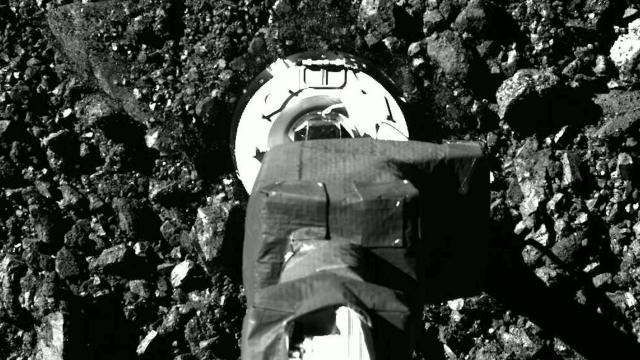After travelling through space for 200 million miles, rocky pieces from asteroid Bennu were dropped off on Earth by the OSIRIS-REx spacecraft in late September. Now, some of those fragments will be put on display for museum-goers to observe firsthand.
The Smithsonian’s National Museum of Natural History will unveil the first public display of the asteroid sample on Friday, November 3. The museum, located in Washington, D.C., will be the first to offer eager space nerds a look at the pristine dark rocks and dust collected from asteroid Bennu.
The sample will be on display at the museum’s Janet Annenberg Hooker Hall of Geology, Gems, and Minerals meteorite gallery. The display will also include scale models of the OSIRIS-Rex spacecraft, on loan from Lockheed Martin, and the Atlas V 411 rocket that carried the spacecraft, on loan courtesy of United Launch Alliance.
“This exhibit is our first chance to share this incredible journey with the public,” Tim McCoy, the museum’s curator of meteorites who has worked on the OSIRIS-REx mission, said in an emailed statement.
Bennu is a small, near-Earth asteroid that makes a close pass to Earth every six years or so. Scientists believe Bennu might have broken off from a much larger carbon-rich asteroid about 700 million to 2 billion years ago, and drifted much closer to Earth since then.
The asteroid was selected as the target of NASA’s OSIRIS-REx mission, which landed on the near-Earth asteroid and snagged a rocky sample in October 2020. The OSIRIS-REx mission dropped off the asteroid samples in the Utah desert on September 24, from where it was transported to the Johnson Space Center where a curation team has been carefully trying to open the canister containing the bulk of the sample. This marked NASA’s first successful attempt to return samples from a distant asteroid (Japan brought back samples of asteroid Ryugu in 2020).
The team recently ran into trouble when two of 35 fasteners on the TAGSAM head, a round head that grabbed the sample from the asteroid, could not be removed. Luckily, there was an abundance of dust and rock on the outside of the TAGSAM head, and team members also managed to extract more of the sample using tweezers and a scoop. NASA is currently devising a plan to safely open the chamber door.
The asteroid samples extracted so far, however, already exceed the mission’s goal of collecting 60 grams of debris from the asteroid, according to NASA. To date, the space agency has recovered 70.3 grams of rocks and dust. Early analysis of the sample found an abundance of carbon and water molecules, just the kind of stuff scientists were hoping to find on NASA’s first returned asteroid sample.
“Having now returned to Earth without being exposed to our water-rich atmosphere or the life that fills every corner of our planet, the samples of Bennu hold the promise to tell us about the water and organics before life came to form our unique planet,” McCoy said.
